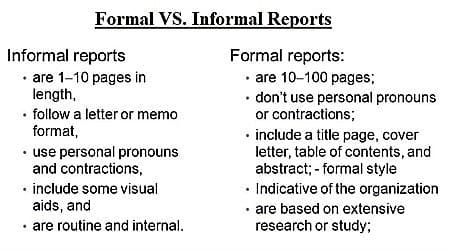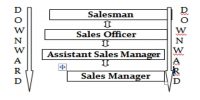Differences between Formal and Informal Reports
Formal and informal reports are the two most common types of business reports. When a report is highly structured and is relatively long in size, it is called a formal report. On the other hand, when a report is less structured and is short in size, it is called an informal report. These two types of reports differ in many ways. Major distinctions between them are as follows:
Formal Report – The reports that are prepared in prescribed forms, according to some established procedures to proper authorities are called formal reports.
- Form of the report: Formal report is highly structured and is prepared in a prescribed format. Most Formal report is always written in a manuscript (narrative style) format.
- Purpose: Formal report is written to help management in making long term and strategic decisions.
- Objective: Objective of the formal report is to assist decision making by providing an effective recommendation.
- Length: It is long in size. Size of a formal report is large. It generally includes some particular pages (e.g. prefatory page) that do not appear in short reports.
- Distribution: In most cases, formal reports are circulated to top-level executives and outside parties.
- Nature of problem: Formal report deals with complex and non-recurring problems. It is analytical and systematic in nature. It deals with key complex problems.
- Frequency of writing: Formal report is written very infrequently.
- Writing responsibility: This type of report is usually written by internal or external experts.
- Use of visual aids: This type of report makes extensive use of visual aids to present the facts and findings.
- Writing Style: This report follows inductive (indirect) and impersonal writing style. A formal report on the other hand, after analyzing and interpreting the conclusion of the draw and makes recommendations.
- Recommendation: Recommendation is an essential part of a formal report.

Informal Report – An informal report is one that is prepared not by following any prescribed rule or formality.
- Form of the report: Informal report is less structured and it is less important to follow the prescribed format. Most Informal reports are written in memorandum and letter formats.
- Purpose: The main purpose of an informal report is to present the facts that help managers in making thy-to-thy business decisions.
- Objective: Conveying routine messages and to help routine functions are the basic objectives of the informal report.
- Length: It is short in size. An informal report is short in size. This report writing is generally complete in a page or two.
- Distribution: Short report is usually circulated within the organization.
- Nature of problem: Informal report deals with less complex and recurring problems. It is not methodical in nature. This report deals with the schedule matters.
- Frequency of writing: It is written very frequently even daily a weekly.
- Writing responsibility: These reports are usually written by a subordinate.
- Use of visual aids: This type of report seldom uses visual aids.
- Writing Style: This report follows deductive (direct) and personal writing style. Informal reports follow deductive writing styles. A short report highlights facts and specific recommendations. It avoids analysis and inclusion of supporting information.
- Recommendations: Recommendations are not required in an informal report.















